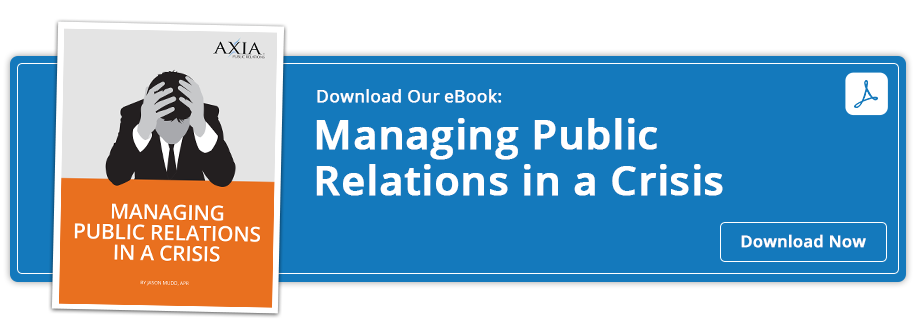Axia Public Relations releases its list of the top PR goofs in 2014
By Axia Public RelationsDecember 18, 2014
 No business wants to deal with a PR crisis. In today’s instant-news world, a mistake or blunder can swiftly tarnish a hard-earned, respected reputation. In 2014, there was no shortage of PR gaffes, and most were avoidable. Axia Public Relations developed a list of the top 2014 preventable PR disasters that prove that even the largest, most well known corporations are not goof-proof.
No business wants to deal with a PR crisis. In today’s instant-news world, a mistake or blunder can swiftly tarnish a hard-earned, respected reputation. In 2014, there was no shortage of PR gaffes, and most were avoidable. Axia Public Relations developed a list of the top 2014 preventable PR disasters that prove that even the largest, most well known corporations are not goof-proof.
A common theme in this year’s list of major PR goofs is the mishandling of social media. Three major players: DiGiorno, a subsidiary of Nestlé, Oreo, owned by Nabisco, and transportation leader DHL all bungled their use of social networking service Twitter in 2014. By using less-than-savvy tactics and little forethought, all three corporations outraged consumers with insensitive and outrageous tweets. The takeaway: Because of the instantaneous and widespread nature of social media, it is critical that companies use extreme care when posting to social media outlets.
In many cases, company employees and spokespeople are not media trained and, as a result, can make contentious statements that don’t reflect the company’s policies or ideology. Such was the case with Uber, when a top executive suggested that the company should spy on reporters by hiring a team to investigate journalists' personal lives and give them a taste of their own medicine. An even higher-profile example was when Microsoft CEO Satya Nadella put his foot in his mouth while speaking at a technology conference for women. He remarked that women who work in the technology field shouldn't ask for raises, but instead, should believe in the "system" to ensure that they get the pay they deserve. In both of these instances, the executives needed more media training. The lesson to remember: Let PR professionals handle your media relation needs.
No stranger to controversy, clothing corporation Urban Outfitters was under fire for creating a faux-vintage Kent State sweatshirt that seemed to allude to the 1970 tragedy in which four students were killed during a Vietnam War protest. The company apologized, saying the reference wasn’t intentional, and pulled the item. But with past instances of controversy, the company’s apology seemed insincere. The lesson here: Be cautious when going for humor in a campaign or promotion. Be absolutely certain it's not offensive.
Sometimes a company has good intentions, but loses sight of the priority. After a major security breach at Home Depot that compromised millions of customers' personal information, within weeks the company was hit again with an attack on its self-checkout system, and over 50 million email addresses were stolen. Home Depot apologized, notified the affected customers, and offered free credit monitoring for a year. It also offered tips on how to avoid identity theft. The preventable tactic: Don't get so caught up in handling the media post-crisis that you don’t focus on the original issue. Fix the problem so it doesn't happen again.
Studies show that every dollar a company spends on crisis planning saves seven during an actual crisis. In today’s fast-paced, all-access environment, it’s critical to have a PR partner at your side to help you handle a crisis and, more importantly, work on preventing one in the first place. Axia PR reminds us, “It takes a lifetime to build a reputation and a minute to destroy it.”
Check out Axia’s e-book for more information about managing PR in a crisis.
Featured image credit: 123rf.com
Topics: public relations, crisis communications


Comment on This Article